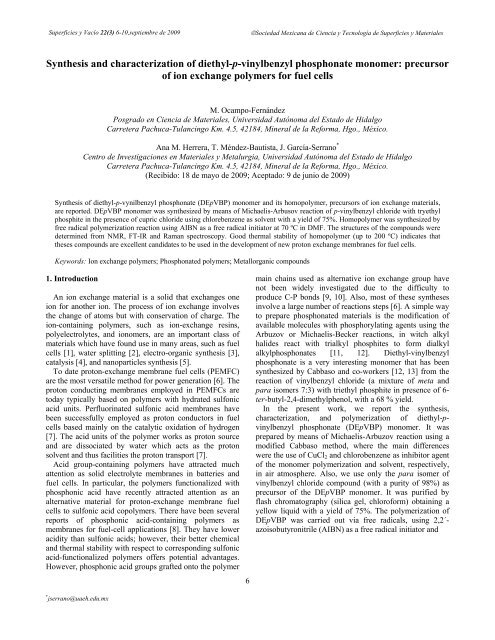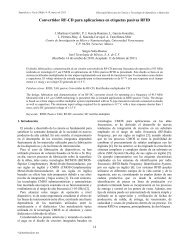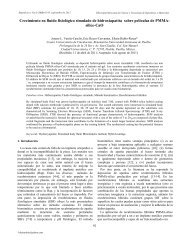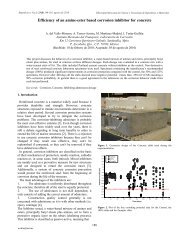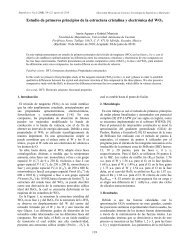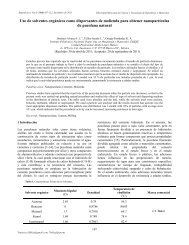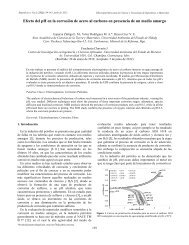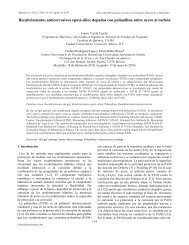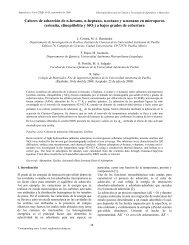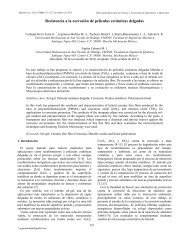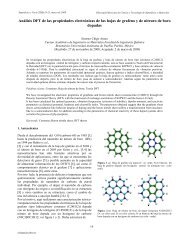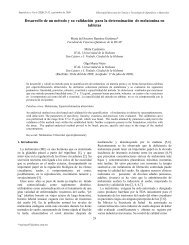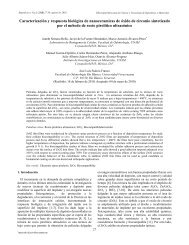Synthesis and characterization of diethyl-p-vinylbenzyl phosphonate ...
Synthesis and characterization of diethyl-p-vinylbenzyl phosphonate ...
Synthesis and characterization of diethyl-p-vinylbenzyl phosphonate ...
You also want an ePaper? Increase the reach of your titles
YUMPU automatically turns print PDFs into web optimized ePapers that Google loves.
Superficies y Vacío 22(3) 6-10,septiembre de 2009©Sociedad Mexicana de Ciencia y Tecnología de Superficies y Materiales<strong>Synthesis</strong> <strong>and</strong> <strong>characterization</strong> <strong>of</strong> <strong>diethyl</strong>-p-<strong>vinylbenzyl</strong> <strong>phosphonate</strong> monomer: precursor<strong>of</strong> ion exchange polymers for fuel cellsM. Ocampo-FernándezPosgrado en Ciencia de Materiales, Universidad Autónoma del Estado de HidalgoCarretera Pachuca-Tulancingo Km. 4.5, 42184, Mineral de la Reforma, Hgo., México.Ana M. Herrera, T. Méndez-Bautista, J. García-Serrano *Centro de Investigaciones en Materiales y Metalurgia, Universidad Autónoma del Estado de HidalgoCarretera Pachuca-Tulancingo Km. 4.5, 42184, Mineral de la Reforma, Hgo., México.(Recibido: 18 de mayo de 2009; Aceptado: 9 de junio de 2009)<strong>Synthesis</strong> <strong>of</strong> <strong>diethyl</strong>-p-vynilbenzyl <strong>phosphonate</strong> (DEpVBP) monomer <strong>and</strong> its homopolymer, precursors <strong>of</strong> ion exchange materials,are reported. DEpVBP monomer was synthesized by means <strong>of</strong> Michaelis-Arbusov reaction <strong>of</strong> p-<strong>vinylbenzyl</strong> chloride with tryethylphosphite in the presence <strong>of</strong> cupric chloride using chlorebenzene as solvent with a yield <strong>of</strong> 75%. Homopolymer was synthesized byfree radical polymerization reaction using AIBN as a free radical initiator at 70 ºC in DMF. The structures <strong>of</strong> the compounds weredetermined from NMR, FT-IR <strong>and</strong> Raman spectroscopy. Good thermal stability <strong>of</strong> homopolymer (up to 200 ºC) indicates thattheses compounds are excellent c<strong>and</strong>idates to be used in the development <strong>of</strong> new proton exchange membranes for fuel cells.Keywords: Ion exchange polymers; Phosphonated polymers; Metallorganic compounds1. IntroductionAn ion exchange material is a solid that exchanges oneion for another ion. The process <strong>of</strong> ion exchange involvesthe change <strong>of</strong> atoms but with conservation <strong>of</strong> charge. Theion-containing polymers, such as ion-exchange resins,polyelectrolytes, <strong>and</strong> ionomers, are an important class <strong>of</strong>materials which have found use in many areas, such as fuelcells [1], water splitting [2], electro-organic synthesis [3],catalysis [4], <strong>and</strong> nanoparticles synthesis [5].To date proton-exchange membrane fuel cells (PEMFC)are the most versatile method for power generation [6]. Theproton conducting membranes employed in PEMFCs aretoday typically based on polymers with hydrated sulfonicacid units. Perfluorinated sulfonic acid membranes havebeen successfully employed as proton conductors in fuelcells based mainly on the catalytic oxidation <strong>of</strong> hydrogen[7]. The acid units <strong>of</strong> the polymer works as proton source<strong>and</strong> are dissociated by water which acts as the protonsolvent <strong>and</strong> thus facilities the proton transport [7].Acid group-containing polymers have attracted muchattention as solid electrolyte membranes in batteries <strong>and</strong>fuel cells. In particular, the polymers functionalized withphosphonic acid have recently attracted attention as analternative material for proton-exchange membrane fuelcells to sulfonic acid copolymers. There have been severalreports <strong>of</strong> phosphonic acid-containing polymers asmembranes for fuel-cell applications [8]. They have loweracidity than sulfonic acids; however, their better chemical<strong>and</strong> thermal stability with respect to corresponding sulfonicacid-functionalized polymers <strong>of</strong>fers potential advantages.However, phosphonic acid groups grafted onto the polymer* jserrano@uaeh.edu.mx6main chains used as alternative ion exchange group havenot been widely investigated due to the difficulty toproduce C-P bonds [9, 10]. Also, most <strong>of</strong> these synthesesinvolve a large number <strong>of</strong> reactions steps [6]. A simple wayto prepare <strong>phosphonate</strong>d materials is the modification <strong>of</strong>available molecules with phosphorylating agents using theArbuzov or Michaelis-Becker reactions, in witch alkylhalides react with trialkyl phosphites to form dialkylalkyl<strong>phosphonate</strong>s [11, 12]. Diethyl-<strong>vinylbenzyl</strong><strong>phosphonate</strong> is a very interesting monomer that has beensynthesized by Cabbaso <strong>and</strong> co-workers [12, 13] from thereaction <strong>of</strong> <strong>vinylbenzyl</strong> chloride (a mixture <strong>of</strong> meta <strong>and</strong>para isomers 7:3) with triethyl phosphite in presence <strong>of</strong> 6-ter-butyl-2,4-dimethylphenol, with a 68 % yield.In the present work, we report the synthesis,<strong>characterization</strong>, <strong>and</strong> polymerization <strong>of</strong> <strong>diethyl</strong>-p<strong>vinylbenzyl</strong><strong>phosphonate</strong> (DEpVBP) monomer. It wasprepared by means <strong>of</strong> Michaelis-Arbuzov reaction using amodified Cabbaso method, where the main differenceswere the use <strong>of</strong> CuCl 2 <strong>and</strong> chlorobenzene as inhibitor agent<strong>of</strong> the monomer polymerization <strong>and</strong> solvent, respectively,in air atmosphere. Also, we use only the para isomer <strong>of</strong><strong>vinylbenzyl</strong> chloride compound (with a purity <strong>of</strong> 98%) asprecursor <strong>of</strong> the DEpVBP monomer. It was purified byflash chromatography (silica gel, chlor<strong>of</strong>orm) obtaining ayellow liquid with a yield <strong>of</strong> 75%. The polymerization <strong>of</strong>DEpVBP was carried out via free radicals, using 2,2´azoisobutyronitrile(AIBN) as a free radical initiator <strong>and</strong>
Superficies y Vacío 22(3) 6-10,septiembre de 2009©Sociedad Mexicana de Ciencia y Tecnología de Superficies y MaterialesClp-<strong>vinylbenzyl</strong>chlorideCl+ POCuCl 2 /90 ºCl+OOOPchloroethaneOOtriethyl phosphite<strong>diethyl</strong>-p-<strong>vinylbenzyl</strong> <strong>phosphonate</strong>Scheme1. Michaelis-Arbuzov reaction <strong>of</strong> <strong>diethyl</strong>-p-vynilbenzyl<strong>phosphonate</strong>.OOPOAIBN /70º CDMF/24hScheme 2. Free Radicals polymerization <strong>of</strong> the <strong>diethyl</strong>-p-<strong>vinylbenzyl</strong><strong>phosphonate</strong>.5467 7`8 6 4 2 0ppmFigure 1. 1 H-NMRspectrum <strong>of</strong> the DEpVBP monomer857 461H 3 CHO2CH 29HC8CH2C6 C 7 C 65 CC4 5CPO3CH 2OH 2 C221CH 3*OO3P3On*11dimethylformamide as solvent at 70ºC with 24 hoursreaction time in argon atmosphere. Formation <strong>and</strong>molecular structures <strong>of</strong> the synthesized compounds wereconfirmed from their infrared (IR), <strong>and</strong> Raman spectra aswell as from their elemental analysis. Thermal stability <strong>of</strong>homopolymer was studied by thermogravimetric analysis(TGA).2. Experimental Section2.1. MaterialsTriethyl phosphate (98% purity), p-<strong>vinylbenzyl</strong> chloride,CuCl 2 <strong>and</strong> AIBN, each with 99% purity, were purchasedfrom Aldrich. Initiator AIBN was recrystallized usingmethanol. All solvents were used as delivered.2.2. <strong>Synthesis</strong> <strong>of</strong> <strong>diethyl</strong>-p-vynilbenzyl <strong>phosphonate</strong>(DEpVBP) monomerDEpVBP monomer was prepared by means <strong>of</strong>Michaelis-Arbuzov reaction (scheme 1) according tomodified method from the reference 13. A 50 mL threeneckedflask equipped with a mechanical stirring device,reflux condenser <strong>and</strong> thermometer was charged with 1.23mL (7.04 mmol) <strong>of</strong> triethyl phosphite, 2 mL (14.19 mmol)<strong>of</strong> p-<strong>vinylbenzyl</strong> chloride, 2 g (7.03 mmol) <strong>of</strong> CuCl 2 asinhibitor <strong>of</strong> the polymerization <strong>of</strong> p-<strong>vinylbenzyl</strong> chloride<strong>and</strong> 1 mL <strong>of</strong> chlorobenzene as solvent. The mixture washeated to 90 ºC for 2 h. After this period, the reactionmixture was cooled at room temperature <strong>and</strong> the unreactedtriethyl phosphite was removed at room temperature invacuum. The crude product was purified by flashchromatography on silica gel using chlor<strong>of</strong>orm, <strong>and</strong> driedat room temperature in vacuum for 12 h, obtaining 1.35 g(yield 75%) <strong>of</strong> DEpVBP monomer as a yellow liquid.Elemental analysis found: C 61 % <strong>and</strong> H 7.2%; calculatedfor C 13 H 19 PO 3 : C 61.41 % <strong>and</strong> H 7.48%. 1 H NMR (400MHz, d 3 -chlor<strong>of</strong>orm): δ 7.39 (d, 8.04 Hz, 2H, Ar-H), 7.33(d, 8.2 Hz, 2H, Ar-H), 6.70 (m, 1H, CH=C), 5.76 (d, 17.57Hz, 1H, C=CH 2 ), 5.27 (d, 10.98 Hz, 1H, C=CH 2 ), 4.11 (m,4H, O-CH 2 ), 1.82 (s, 2H, CH 2 -P), 1.33 (t, 6.96 Hz, 6H, C-CH 3 ). 13 C APT NMR (100 MHz, d 3 -chlor<strong>of</strong>orm): δ 16.02(CH 3 ), 46.02 (CH 2 ), 63.69 (CH 2 ), 114.75 (CH 2 =), 126.51(Ph), 129.03 (Ph), 136.35 (CH=), 136.95 (Ph), <strong>and</strong> 137.75ppm (Ph). FT-IR (KBr pellets): 3088, 2979, 2929, 2868,2342, 1913, 1828, 1681, 1630 (vinyl C=C), 1608 (Ar C=Cstretch), 1569, 1512, 1479, 1443, 1421, 1405, 1375, 1266(P=O stretch) , 1214 1166, 1113, 1099 (P-O-Cstretch),1032 (P-O-C stretch), 989, 912, 843, 730, 682,629, 542, 483 <strong>and</strong> 430 cm -1 .9150 100 50 0ppmFigure 2. 13 C APT NMR spectrum <strong>and</strong> molecular structure <strong>of</strong> theDEpVBP monomer.7
Superficies y Vacío 22(3) 6-10,septiembre de 2009©Sociedad Mexicana de Ciencia y Tecnología de Superficies y MaterialesTransmittance (a.u)100806040200100806040200DEpVBPpoly(DEpVBP)C=Cvinyl4000 3500 3000 2500 2000 1500 1000 500Wavelength (cm -1 )Figure 3. IR spectra <strong>of</strong> the DEpVBP <strong>and</strong> poly(DEpVBP).Intensity (a.u)42012840DEpVBPpoly(DEpVBP)C=Cvinyl3500 3000 2500 2000 1500 1000 500Raman shift / cm -1C=CAromaticC=CAromaticFigure 4. Raman spectra <strong>of</strong> the DEpVBP <strong>and</strong> poly(DEpVBP).2.3. <strong>Synthesis</strong> <strong>of</strong> homopolymer poly(<strong>diethyl</strong>-p-<strong>vinylbenzyl</strong>posphonate)DEpVBP monomer was polymerized by free radicalsreaction in DMF using AIBN as a free radical initiator(scheme 2). 0.635 g <strong>of</strong> monomer <strong>and</strong> 8.62 mg (2 wt % <strong>of</strong>the monomer) <strong>of</strong> initiator were charged in a glass test tubecontaining 1 mL <strong>of</strong> DMF, which was bubbled with argongas for 20 min. The test tube was then sealed under argon<strong>and</strong> placed in a constant temperature (70 ºC) water bath for24 h. After this period, the reaction mixture was cooled toroom temperature, <strong>and</strong> the polymer was isolated byprecipitation <strong>of</strong> the product in cold water (10 times thevolume <strong>of</strong> the reaction mixture) <strong>and</strong> with subsequentdrying at 90 ºC in vacuum for 2 h. The homopolymer inform <strong>of</strong> a light brown solid was obtained with a 68 % yield(0.432 g).2.4. Characterization1 H NMR <strong>and</strong> 13 C APT NMR spectra <strong>of</strong> the samples wererecorded on JEOL 400 (400 MHz/100 MHz) NMRspectrometer, using deuterated chlor<strong>of</strong>orm <strong>and</strong> tetramethylsilane (TMS) as the internal reference. IR spectra wererecorded on a Perkin-Elmer Spectrum GX FT-IRspectrophotometer, with a spectral resolution <strong>of</strong> 4 cm -1 . ForFTIR studies, 1 mg <strong>of</strong> solid sample was mixed with 99 mg<strong>of</strong> dry KBr homogeneously to make pellets <strong>of</strong> 7 mmdiameter <strong>and</strong> 0.5 mm thick. Raman spectra were recordedon a Raman Perkin-Elmer system 2000 spectrophotometer.Elemental analysis <strong>of</strong> the samples was carried out on aPerkin-Elmer C, H, N analyzer (model 2400).Thermogravimetric measurements <strong>of</strong> the compounds werecarried out with a Mettler-Toledo thermal analyzerTGA/SDTA 851. The measurements were performed fromroom temperature to 500 ºC, at a heating rate <strong>of</strong> 10°C/minunder nitrogen atmosphere.Weight(%)1008060121º+208º, loss 3.4%+305º, loss 13.2%+430º, loss 23.1% +400 200 400Temperarure (º C)Figure 5. TGA curve <strong>of</strong> poly (DEpVBP).+492º, loss 10.7%83. Results <strong>and</strong> discussion3.1. Monomer <strong>characterization</strong>Formation <strong>and</strong> molecular structure <strong>of</strong> the DEpVBP wasconfirmed from their 1 H NMR, 13 C APT NMR, infrared,<strong>and</strong> Raman spectra. Figure 1 shows the 1 H NMR spectrum<strong>of</strong> the DEpVBP monomer <strong>and</strong> the results are summarizedin the Table 1. The most important signals for thecompound, which indicate its formation were the multipletat 6.70 ppm assigned to the proton on the CH=C group, thedoublets at 5.76 <strong>and</strong> 5.27 ppm assigned to the protons onthe CH 2 =C, the multiplet at 4.11 ppm assigned to theprotons on O-CH 2, the singlet localized at 1.82 ppmcorresponding to the protons <strong>of</strong> P-CH 2 , <strong>and</strong> the triplet at1.33 ppm for the protons <strong>of</strong> CH 3 -C group.The 13 C APT NMR spectrum <strong>of</strong> the DEpVBP (Figure 2)revealed nine signals. The main signals that confirming theformation <strong>of</strong> compounds were localized at 114.74 <strong>and</strong>
Superficies y Vacío 22(3) 6-10,septiembre de 2009©Sociedad Mexicana de Ciencia y Tecnología de Superficies y Materiales136.35 ppm corresponding to the C atoms <strong>of</strong> the vinylgroup; the signals at 16.02 <strong>and</strong> 63.69 ppm due to the Catoms on the CH 3 <strong>and</strong> CH 2 <strong>of</strong> the <strong>diethyl</strong>-<strong>phosphonate</strong>group, respectively.Formation <strong>of</strong> the DEpVBP is also evident from their FTIR<strong>and</strong> Raman spectra (see Fig. 3 <strong>and</strong> Fig. 4). IR spectrumrevealed strong absorption b<strong>and</strong>s due to the P=O stretchingvibration mode at 1266 cm -1 , P-O-Et stretching at 1099-1020 cm -1 , P-O-C stretching at 989 cm -1 , all correspondingto the –PO(CH 2 CH 3 ) group; C=C stretching vibration modeat 1630 cm -1 <strong>of</strong> vinyl group; <strong>and</strong> C=C stretching at 1608cm -1 <strong>of</strong> phenyl group. These assignments were based onliterature vibrational studies <strong>of</strong> organic <strong>and</strong> <strong>phosphonate</strong>materials [14-17]. On the other side, in the Ramanspectrum the signals corresponding to the C=C stretchingmodes <strong>of</strong> the vinyl <strong>and</strong> phenyl groups appeared at 1630 cm -1 <strong>and</strong> 1607 cm -1 , respectively.3.2. Polymer <strong>characterization</strong>The poly(DEpVBP) homopolymer was found to besoluble in several polar solvents like ethanol, methanol,DMF, <strong>and</strong> DMSO; but insoluble in toluene, ciclohexane,<strong>and</strong> water. Formation <strong>of</strong> the homopolymer was followed byRaman <strong>and</strong> IR spectroscopies. Fig. 3 <strong>and</strong> Fig. 4 show theIR (4000-400 cm -1 ) <strong>and</strong> Raman (in the spectral range <strong>of</strong>3500-500 cm -1 ) <strong>of</strong> the monomer <strong>and</strong> polymer, indicatingthe region correspond to the C=C stretch. Is clear fromRaman spectra that the principal evidence <strong>of</strong> polymerformation came from the disappearance <strong>of</strong> the signal due toC=C stretching vibration mode <strong>of</strong> vinyl group <strong>of</strong> themonomer. In the IR spectrum <strong>of</strong> the polymer (Figure 3)also the absorption b<strong>and</strong> due to C=C stretching <strong>of</strong> the vinylgroup is absent.Thermal stability <strong>of</strong> the poly(DEpVBP) was studiedthrough thermogravimetric measurements realized at aheating rate <strong>of</strong> 10°C/min under nitrogen atmosphere.Figure 5 Termogravimetric curve <strong>of</strong> the polymer showsdistinct regions <strong>of</strong> weight loss with the increase <strong>of</strong>temperature. The first, a gradual weight loss <strong>of</strong> about 3.4 %in the temperature range 120-208 °C was attributed to theevaporation <strong>of</strong> water <strong>and</strong> DMF. In the second region (208-305 °C), about 13.2 % <strong>of</strong> the weight loss was associated tothe partial thermal degradation <strong>of</strong> poly(DEpVBP) due tothe loss <strong>of</strong> the ethyl ester group <strong>of</strong> the <strong>vinylbenzyl</strong>phosphate. Thermal degradation <strong>of</strong> VBP due to the loss <strong>of</strong>ester groups has been reported at 240-250 °C [13].Progressive thermal degradation <strong>of</strong> the polymer observedbetween 305 <strong>and</strong> 500 °C, is probably due to thedegradation <strong>of</strong> the main chain <strong>of</strong> polymer <strong>and</strong> thedegradation <strong>of</strong> P-C bonds <strong>of</strong> the pendant group <strong>of</strong> polymer.These results indicate that the poly(DEpVBP) synthesizedis stable until 208 °C. Above this temperature, thedegradation <strong>of</strong> polymer occurs in several steps, resulting inthe loss <strong>of</strong> about 47 % <strong>of</strong> the weight <strong>of</strong> polymer.4. ConclusionsDEpVBP monomer was synthesized by means <strong>of</strong>Michaelis-Arbusov reaction using CuCl 2 as inhibitor agent<strong>and</strong> chlorebenzene as solvent, with a yield <strong>of</strong> 75%.<strong>Synthesis</strong> process permits to improve the yield on reported(68%). Poly(DEpVBP) synthesized by free radicalspolymerization shows a good thermal stability until 208 ºC.Molecular structures <strong>of</strong> the synthesized compounds wereconfirmed by 1 H NMR, 13 C APT NMR, IR, <strong>and</strong> Ramanspectroscopies. Owing to the ion exchange capacityconferred by the <strong>phosphonate</strong> group <strong>and</strong> the good thermalTable 1. Assignment <strong>of</strong> 1 H-NMR peak positions <strong>of</strong> the DEpVBP monomer.Chemical Shiftδ (ppm)Integration MultiplicityJ H-H(Hz)AssignmentH 7'H CH1.82 2 s --- H 3 1 C H 2 CH 2 21.33 6 t 6.96 H 1 27.39 2 d 8.04 H 55 H7.33 2 d 8.2 H 46.70 1 m --- H 64 H5.76 1 d 7.57 H 7O5.27 1 d 10.98 H 7’P4.11 4 m --- H 2OH 3 C O7CCH 236CH 31H 5H 4s = singlet, d = doublet, t = triplet <strong>and</strong> m = multiplet9
Superficies y Vacío 22(3) 6-10,septiembre de 2009©Sociedad Mexicana de Ciencia y Tecnología de Superficies y Materialesstability <strong>of</strong> polymer, the DEpVBP <strong>and</strong> poly(DEpVBD) isunder study by our research group for the synthesis <strong>of</strong>copolymers useful as polymer exchange membranes forfuel cells.AcknowledgmentsM. Ocampo-Fern<strong>and</strong>ez acknowledges to CONACyT,Mexico for the graduate fellowship. The work was partiallysupported by PROMEP, Mexico.References[1]. Itoh T.; Hamaguchi Y.; Uno, T.; Kubo, M.; Aihara, Y.;Sonai, A. Solid State Ionics, 177, 185 (2006).[2]. Linkous, C. A.; Anderson, H.R.; Kopitzke, R.W.; Nelson,G.L. Int. J. Hydrogen Energy, 23, 525 (1998).[3]. Madden, T. H.; Stuve, E. M.; J. Electrochem. Soc., 150,E571 (2003).[4]. Bryant, D. E.; Kilner, A. J. Mol. Catal. A: Chem., 193, 83(2003).[5]. García-Serrano, J.; Pal, U.; Herrera, Ana M.; Salas, P.;Angeles-Chavez, C. Chem. Mater. 20, 5146 (2008).[6]. Gudrun Schmidt-Naake, Chem. Eng. Technol, 28, (2005).[7]. Donald J. Burton, Journal <strong>of</strong> Fluorine Chemistry, 82, 13(1997).[8]. Parvole, J. Macromolecules, 41, 3893 (2008).[9]. Kotov, S.; Burton, D. J. Fluorine Chem. 82, 13 (1997).[10]. Jakoby, K.; Nunes, S. P. Macromol.Chem.Phys., 204, 61(2003).[11]. Bhattacharya, A.; Thyagarajan, G. Chem. Rev. 81, 415(1981).[12]. Cabasso, I.; Yu, Z. J. Polym. Sci. Part A 28, 227 (1990).[13]. Tamber, H.;Smid J.; Cabasso I. Chem. Mater 9, 1335 (1997).[14]. Nakanishi, K. Infrared absorption spectroscopy (Holden-Day, San Francisco, 1962).[15]. Danilich, M.J.; Burton, D.J.; Marchant, R.E. Vib.Spectroscopy 9, 229 (1995)[16]. Popa, A., Davidescu, C.M.; Negrea, P.; Ilia, G.; Katsaros,A.; Demadis, K.D. Ind. Eng. Chem. Res. 47, 2010 (2008).[17]. Yamabe, M.; Akiyama, K.; Akatsuka, Y.; Kato, M.European Polymer Journal 36, 1035 (2000).10


